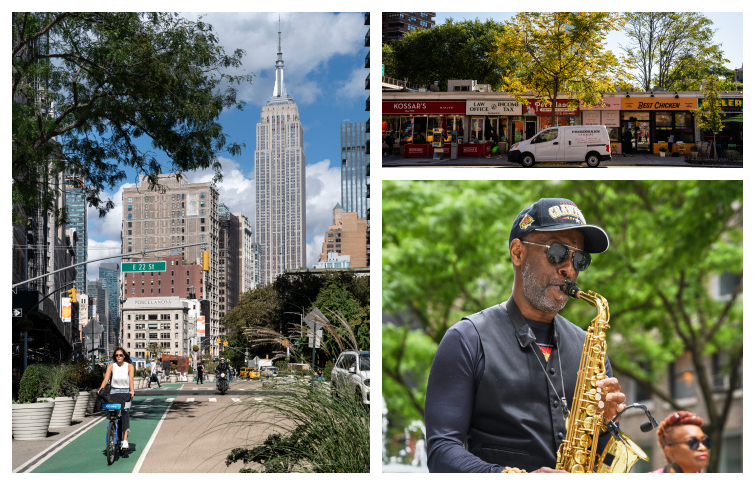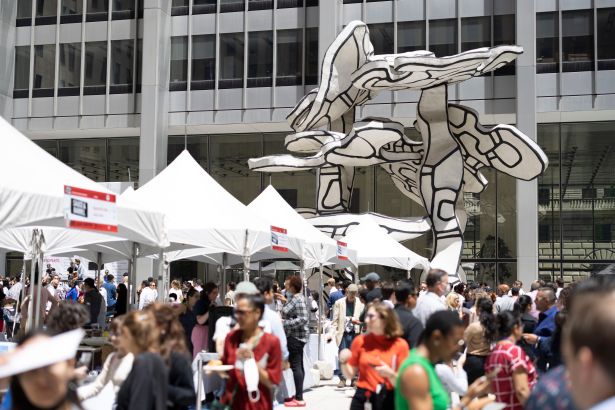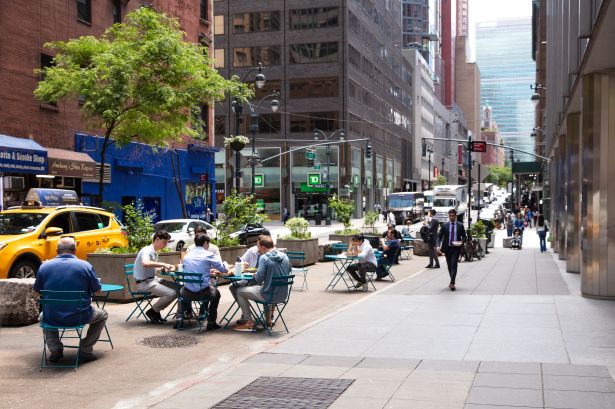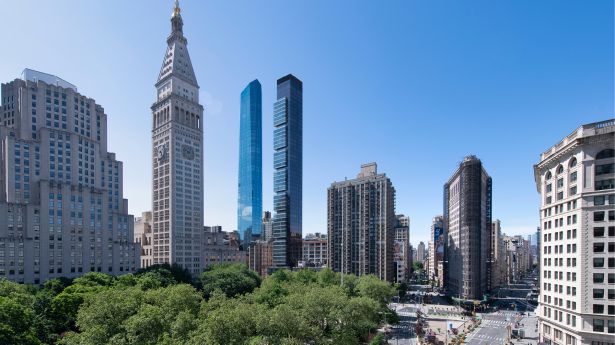Presented By: Partner Insights
How New York City’s BIDs Work to Keep Neighborhood Streets Clean, Safe and Fun
By Partner Insights July 21, 2023 8:00 am
reprints
New York City is always a city in transition in one way or another. But most would agree that the current moment of office turmoil has accelerated a change that finds our central business districts less populated than in years past, affecting retailers citywide.
The city’s neighborhood associations and business improvement districts (BIDs) have long worked hard to create welcoming neighborhood environments for workers, visitors and tourists alike, taking steps to beautify the city while making it safer, more entertaining and generally more desirable places for people to spend their time.
And with the city facing declining pedestrian counts and office occupancy numbers, their work is as important as ever.
The Alliance for Downtown New York has been doing this work since 1995 for the area bordered by City Hall, the Battery, the East River and West Street.
Alliance president Jessica Lappin tells Commercial Observer about some of the many ways her BID has been supporting area retailers.
“We launched a program called Get Social where we pair select independent retailers with digital consulting experts on the social media side,” said Lappin. “Thirty businesses are getting one-on-one mentoring and AP photographs so they can update their carousel for social, and $1,500 grants for social advertising.”
To assist local restaurants, the Alliance recently held its annual Dine Around Downtown Community Food Festival at Fosun Plaza, where area restaurants offered lunchtime samples of signature menu items for $5 to $9.
“We had a gorgeous day for it,” said Lappin. “We had about 12,000 people who came by to sample food from the 42 restaurants that participated. That was a nice celebration. When 12,000 people come, you feel the energy.”
The Alliance also created the “Art Is All Around” series, which saw the installation of two interactive art pieces the public could enjoy throughout May and June, accompanied by a lunchtime concert series of local blues and jazz artists on Wednesdays. The organization also recently launched an incubator program that will bring more educational and entertaining walking tours to the area.

“We had five winners who are getting grants of up to $12,500 and, almost as important, access to a curriculum on how to do this,” said Lappin. “We have Christopher Street Tours, which will focus on the LGBTQ history in Lower Manhattan; one focused on the Seaport and the history there; Inside Out, which will be a food tour celebrating artisan vendors in the area; Awesome Walks, which is focused very specifically on small businesses and promoting some of our leaders; and then Vivace Tours, which is focused on the history of faith in Lower Manhattan and how significant this neighborhood was in the development of faith over the centuries for multiple religions.”
It’s Lappin’s hope that events and installations like these will help remind people why they love New York.
“Tourism has rebounded more quickly than we expected,” said Lappin. “We have quiet days that don’t resemble before the pandemic, and then many days, frankly, that do. We had been doing placemaking before the pandemic, but we’re definitely doubling down now.”
As with all BIDs, the Alliance’s work encompasses both the fun and the practical. On the latter side, they recently launched a pilot program along with the Department of Sanitation for streetside compositing that was so successful it will be expanded throughout the city.
“They will be taking over for us at some point this summer,” said Lappin. “The bins we piloted for them were hugely successful, with over 2,500 users, 40 percent of whom said it was the first time they were ever composting. People really love it.”

Over at the Grand Central Partnership, which covers the area in Midtown bordered by 35th Street, 54th Street, Second Avenue and Fifth Avenue, President and CEO Fred Cerullo reports that area visitations are looking up.
“As of May, pedestrian activity was at 75 percent of pre-COVID numbers compared to May 2019,” said Cerullo. “But also, we topped the 8 million mark for pedestrian activity that month, which was only the second time that’s occurred since before COVID. So the number of people who are making their way around the district is strong.”
Cerullo also said that the area’s weekend foot traffic is at least as strong as it was pre-COVID, if not stronger at certain points.
“People are using the neighborhood differently than they did pre-COVID,” said Cerullo. “I think that could be because people are staying closer to home. That’s helped us think about programming things on the weekend, and how we manage public spaces.”
One event that has burnished area traffic was the introduction of the Long Island Rail Road station at Grand Central this past February, which Cerullo said increased local traffic from Long Island residents by roughly 50 percent.
All of this has been good news for the local retail scene, which Cerullo reports is booming.
“We’ve had a hundred new businesses open in the district over the past year,” said Cerullo. “These have been mostly food and beverage, which is fantastic because they are destination-driven businesses. We also currently have about 35 retail spaces in buildout to welcome new tenants — the highest number of buildout locations we’ve seen at one time since 2017.”
On the recreational front, the Partnership has continued previous efforts to create more welcoming outdoor spaces in the area.
“Public space activations are a way of life for us,” said Cerullo. “This spring, we opened a 120-foot street seat on Vanderbilt Avenue with tables, chairs and umbrellas, and we added tables and chairs to a similar project on 43rd Street. It’s really turned the block into a different sort of activated space, which is nice to see.”
In February, the Partnership hosted Grand Gourmet — The Flavor of Midtown, which showcased 25 area restaurants for local residents and visitors. After the event, the organization delivered over 200 pounds of leftover food to Unity Faith Outreach, a Brooklyn food pantry.
The Partnership will also be presenting music and art throughout the summer. The Rudin Summer Concert Series, hosted by the Rudin Family, will present free lunchtime concerts on Wednesdays at 345 Park Avenue throughout the summer, and the Pershing Square Sounds series offers free shows at Pershing Square Plaza West at lunchtime on Tuesday and for an after-work happy hour on Wednesdays.
A bit further downtown, one concentration of the former Flatiron/23rd Street Partnership over the past year has seen an expansion.
In January 2022, the Partnership expanded its boundaries beyond the Flatiron District to include all of NoMad to the north, 20th Street to the south, and seven more blocks of Sixth Avenue to the west.
Last May, the organization renamed itself the Flatiron NoMad Partnership.

“While 23rd Street is a very important retail corridor, the center of gravity when it came to the vibrancy and mixed-use nature of our neighborhood was moving north a bit,” said James Mettham, president of the Flatiron NoMad Partnership. “Flatiron has all the history, a terrific base for commerce, and great amenities. But the NoMad neighborhood north of Madison Square Park was becoming a destination for hospitality, for new residential, and for new office as well.”
Mettham said that while office return rates in his area are at roughly 60 to 70 percent of pre-pandemic levels, overall pedestrian levels are up around 80 to 90 percent, which he attributes to changes in the very nature of the city in the wake of COVID.
“This shows the transformation of the historic business district, 9-to-5 mentality. Now, it’s more of a 24/7 district,” said Mettham. “That’s from a mix of visitors returning to many of the great hotels. A lot of people come through to photograph the Flatiron Building, plus the retail and dining options here are exquisite.”
Another factor in the uptick is that while the area, like the city as a whole, has shed a certain number of office workers, it is growing rapidly as a residential destination.
“We’ve seen significant growth in the number of people living in the neighborhood,” said Mettham. “We’ve had about an 18 to 20 percent jump in housing units over the past decade.”
To support all this growth and change, one of the organization’s significant recent efforts on behalf of the community is the establishment and expansion of pedestrian plazas.
“We’ve expanded people-first Broadway up from 25th Street to 32nd Street, and from 23rd Street down to 21st Street,” said Mettham of the no-cars-allowed sections of one of Manhattan’s central avenues. “Now it’s a cohesive ribbon of beautified space where people can sit and enjoy a bite to eat, whether at a public seating or a terrific dining venue. We’ve worked closely with the city in repaving and reconfiguring it to make it more meandering and piazza-like.”
Mettham said that these improvements give the area a whole new look and feel, from a series of two-way bike lanes to the new plaza that runs from 25th Street to 31st Street, known as NoMad Piazza.
“It’s about creating a place you want to be, whether you’re shopping, visiting or coming for a cocktail,” said Mettham.

The Lower East Side Partnership has a somewhat different task than other BIDs, given its neighborhood’s status as less of a daytime office district than a nighttime party center. This leaves them with a somewhat different set of challenges.
“We have one of the most significant concentrations of adjacent established liquor licenses throughout the city,” said Tim Laughlin, president of the Lower East Side Partnership. “That obviously makes the neighborhood a destination for nighttime activity. But we have also been actively encouraging daytime foot traffic.”
One of their greatest consistent challenges, then, is ensuring that the neighborhood is ready for business in the morning after a night serving as party central.
“There are a lot of things that happen on the street when you have an active nightlife. It doesn’t just magically end up clean at 5 a.m.,” said Laughlin. “We work really hard to make sure that we’re recovered as soon as possible in the morning, so that both daytime business activity and residents who are heading out to work experience a clean and welcoming street.”
When it comes to recreational and leisure activity, Laughlin said the neighborhood is consistently robust, showing activity at least as great as pre-pandemic, if not greater.
“Nighttime traffic is about equal to what it was pre-COVID, and our daytime brunch hours might have increased,” said Laughlin. “The use of the street for dining has actually encouraged more of a robust daytime weekend commerce environment. People are coming to the Lower East Side as a unique destination — as an authentic New York City community. They’re brunching, and then they’re shopping.”
One great new advantage for the Lower East Side over the past few years has been the introduction of the Essex Crossing project, and its newly renovated Essex Market.
“We have several programmatic relationships with that facility,” said Laughlin. “We support the small-format vendor community. We offer a variety of different cooking and nutrition classes, and programming that’s geared towards low- and moderate-income residents. We also do a variety of different events, whether for a holiday or a weekend promotion or a tasting, that really draw people to the market and, therefore, to the neighborhood.”
Laughlin, like his compatriots at BIDs throughout the city, believes programs like these can ultimately make New York City a warmer and more inviting place for people to spend their time, which in turn creates a nurturing environment for businesses of all types and sizes.
“We’re working with our restaurateurs on the new rollout of an open restaurant program, and the next iteration of what that looks like,” said Laughlin. “We’re also thinking more holistically about the management of the curb — how are we incorporating outdoor dining, trash collection, and loading and unloading in a way that is inviting, encourages commerce and doesn’t impede on residential quality of life. All those pieces of the puzzle coming together, I think, are the secret sauce to making New York City streets vibrant, and also a big component of economic development throughout the five boroughs.”


